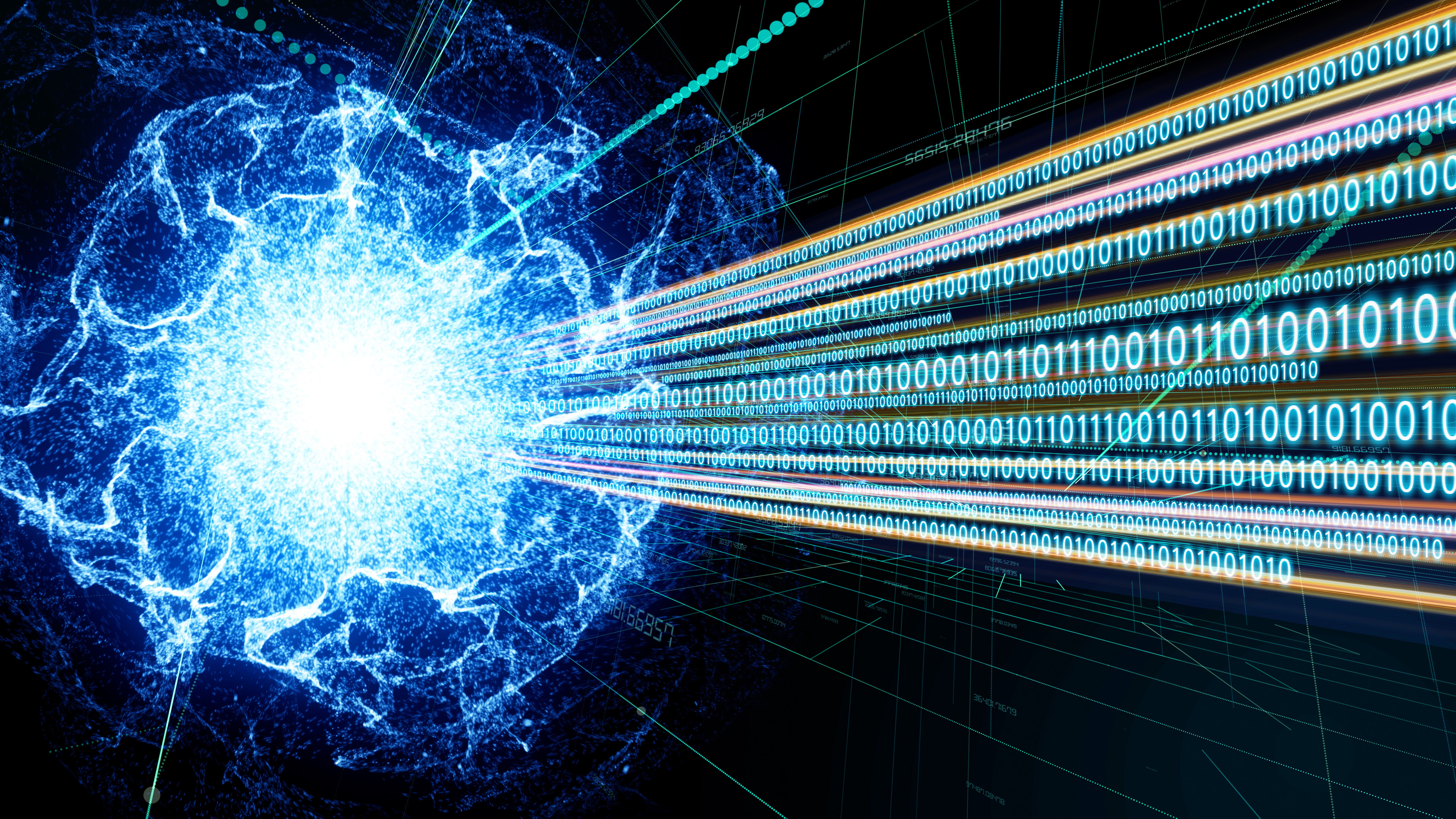
Webinar series presented by the Institute for Materials Research (IMR) and Institute for Optical Science (iOS)
The Frontiers in Quantum Information Science and Engineering (QISE) webinar series will welcome world leaders in the field to paint a broad perspective of the current state of QISE and look toward the future of this rapidly evolving landscape. Topics covered will include the full spectrum of science and engineering opportunities in QISE, including quantum computing, quantum sensing and quantum communication technologies, as well as the fundamental principles, materials development and measurement challenges central to their rapid advance.
Each webinar will be followed by an open discussion with the speaker, providing a unique opportunity for both experts and novices in QISE to come up to speed with the latest developments and challenges in this rapidly evolving field. Please join us by using the link above to find more information about the series and invited speakers.
> Download the flyer
Series Schedule
Error correction of logical quantum bits encoded in a superconducting cavity
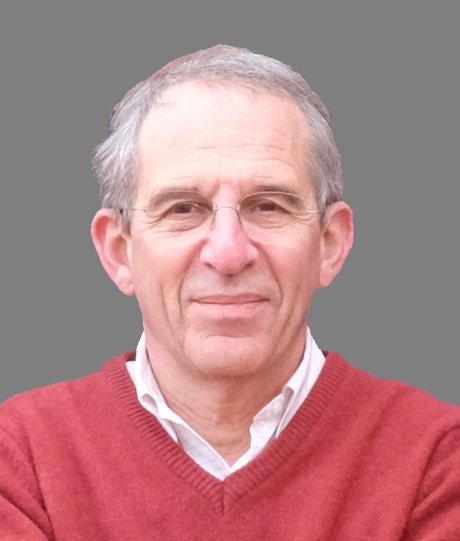 Michel Devoret
Michel Devoret
F.W. Beinecke Professor of Applied Physics, Yale University
Friday, Jan. 15, 2021 at 3:30 p.m.
Watch the presentation here
Abstract:
The accuracy of logical operations on quantum bits (qubits) must be improved for quantum computers to surpass classical ones in useful tasks. To that effect, quantum information must be robust to noise that affects the underlying physical system. Rather than suppressing noise, quantum error correction aims at preventing it from causing logical errors. This approach derives from the reasonable assumption that noise is local: it does not act in a coordinated way on different parts of the physical system. Therefore, if a logical qubit is encoded non-locally, it is possible, during a limited time, to detect and correct noise-induced evolution before it corrupts the encoded information. We will discuss how recent experiments [1, 2] based on superconducting cavities and transmon artificial atoms – employed here as ancillary non-linear elements – realize this error correction, and its prospect for reservoir engineering implementations that would realize the desirable next stage: autonomous quantum error correction.
[1] Grimm et al. , Nature, 584, 205–209 (2020); [2] Campagne-Ibarcq et al., Nature, 584, 368-372 (2020).Bio:
Michel Devoret graduated from Ecole Nationale Superieure des Telecommunications in Paris in 1975 and started graduate work in molecular quantum physics at the University of Orsay. He then joined Professor Anatole Abragam’s laboratory in CEA-Saclay to work on NMR in solid hydrogen, and received his PhD from Paris University in 1982. He spent two post-doctoral years working on macroscopic quantum tunneling with John Clarke’s laboratory at the University of California, Berkeley. He pursued this research on quantum mechanical electronics upon his return to Saclay, starting his own research group with Daniel Esteve and Cristian Urbina. The main achievements of the “quantronics group” were in this period the measurement of the traversal time of tunneling, the invention of the single electron pump (now the basis of a new standard of capacitance), the first measurement of the effect of atomic valence on the conductance of a single atom, and the first observation of the Ramsey fringes of a superconducting artificial atom (quantronium). He became director of research at the Commissariat a l’Energie Atomique (CEA) at Saclay. In 2007, Michel has been appointed to the College de France, where he taught until 2012. He is a member of the American Academy of Arts and Sciences (2003) and a member of the French Academy of Sciences (2008). Michel has received the Ampere Prize of the French Academy of Science (together with Daniel Esteve, 1991), the Descartes-Huygens Prize of the Royal Academy of Science of the Netherlands (1996) and the Europhysics-Agilent Prize of the European Physical Society (together with Daniel Esteve, Hans Mooij and Yasunobu Nakamura, 2004). He is also a recipient of the John Stewart Bell Prize, which he received jointly with Rob Schoelkopf in 2013. In 2014, he has been awarded, together with John Martinis and Rob Schoelkopf, the Fritz London Memorial Prize. He received the Olli Lounaasma Prize in 2016.
Currently the F. W. Beinecke Professor of Applied Physics at Yale University — which he joined in 2002 — he focuses his research on experimental solid state physics with emphasis on quantum superconducting circuits for quantum information processing. In this new type of circuits based on Josephson junctions, electrical collective degrees of freedom like currents and voltages behave quantum mechanically. He currently focuses on the new phenomena of fault-tolerant quantum operations and remote entanglement.
Quantum Computing with Atoms
 Christopher Monroe
Christopher Monroe
Professor of Electrical and Computer Engineering and Physics, Duke University;
Founder and Chief Scientist, IonQ Inc.
Friday, Jan. 29, 2021 at 3:30 p.m.
Watch the presentation here
Abstract:
Trapped atomic ions are the unique quantum computing physical platform that features qubits with essentially infinite idle coherence times. Such atomic clock qubits are controlled with laser beams, allowing densely-connected and reconfigurable universal gate sets. Unlike all other physical platforms for quantum computing, the path to scale involves concrete architectural paths, from shuttling ions between QPU cores to modular photonic interconnects between multiple QPUs. Full-stack ion trap quantum computers have thus moved away from the physics of qubits and gates and toward the engineering of optical control signals, quantum gate compilation for algorithms, and high level system design considerations. I will summarize the state-of-the-art in these quantum computers and speculate on how they might be used.
Bio:
Christopher Monroe is Professor of ECE and Physics at Duke University and the co-Founder and Chief Scientist of IonQ, Inc. Monroe specializes in the isolation of individual atoms for applications in quantum information science. At NIST in the 1990s, Monroe led the team that demonstrated the first quantum logic gate. At the University of Michigan (2000-2007) and the University of Maryland (2007-2020), Monroe’s research group pioneered all aspects of trapped atomic ion based quantum computers, making the first steps toward a scalable, reconfigurable, and modular quantum computer system. In 2016, he co-founded IonQ, a startup company leading the way in the fabrication of full-stack quantum computers. Monroe is a member of the National Academy of Sciences and is one of the key architects of the recent U.S. National Quantum Initiative.
Quantum Information Science Landscape and NIST
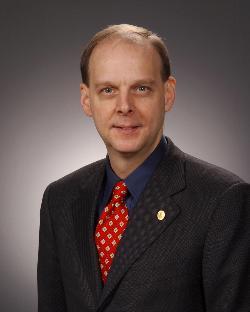 Carl Williams
Carl Williams
Carl Williams, National Institute of Standards and Technology
Friday, Feb. 19, 2021 at 3:30 p.m.
Watch the presentation here
Abstract:
In the early 1900’s, Niels Bohr, Albert Einstein and others laid the foundations of quantum mechanics — nature’s instruction book for the smallest particles of matter. Now 100 years later researchers are primed to harvest the fruits of basic research resulting from Quantum Information Science – the confluence of Information Science and Quantum Mechanics – two of the revolutionary developments of the 20th Century. Quantum information scientists have already convincingly demonstrated the long-term feasibility of these new approaches and there are now an emerging number of niche applications, including NIST’s own quantum logic clock as well as revolutionary new approaches to communication and computing.
This webinar is focused on providing a high-level view of the evolving research and developmental opportunities enabled by this emerging disruptive technology that will transform the 21st Century. I will start with a description of the national and international landscape that led to the passage of the National Quantum Initiative (NQI) Act in December 2018. I will then describe NIST’s role within the NQI and describe a few NIST highlights that point to possible future applications of this emerging technology beyond quantum computing. The main part of the talk will describe how the academic, industrial, and services sectors will likely be transformed by this technology with a focus on the R&D and educational opportunities they present to a Tier I research university. I will conclude with a few remarks on the implications of this technology for science, the economy, and public welfare.
Bio:
Dr. Carl J. Williams (https://www.nist.gov/people/carl-j-williams) is the Deputy Director of the Physical Measurement Laboratory (PML), National Institute of Standards and Technology (NIST). He is a Fellow of the Joint Quantum Institute (http://jqi.umd.edu), the Joint Center for Quantum Information in Computer Science (http://quics.umd.edu), and Adjunct Professor of Physics at the University of Maryland.
Dr. Williams received his B.A. in Physics from Rice University in 1981, his Ph.D. from the University of Chicago in 1987, joined NIST in 1998. In 2006, Dr. Williams helped establish the Joint Quantum Institute (JQI) and is the NIST lead in establishing the Quantum Economic Development Consortium (QED-C). He is a Fellow of the American Physical Society, the American Association for the Advancement of Science, and the Washington Academy of Science. He is an Associate Editor of the Journal of Quantum Information and Computation, has authored over 120 scientific publications, and has been a speaker at numerous national and international conferences.
Exploring New Frontiers with Programmable Quantum Systems
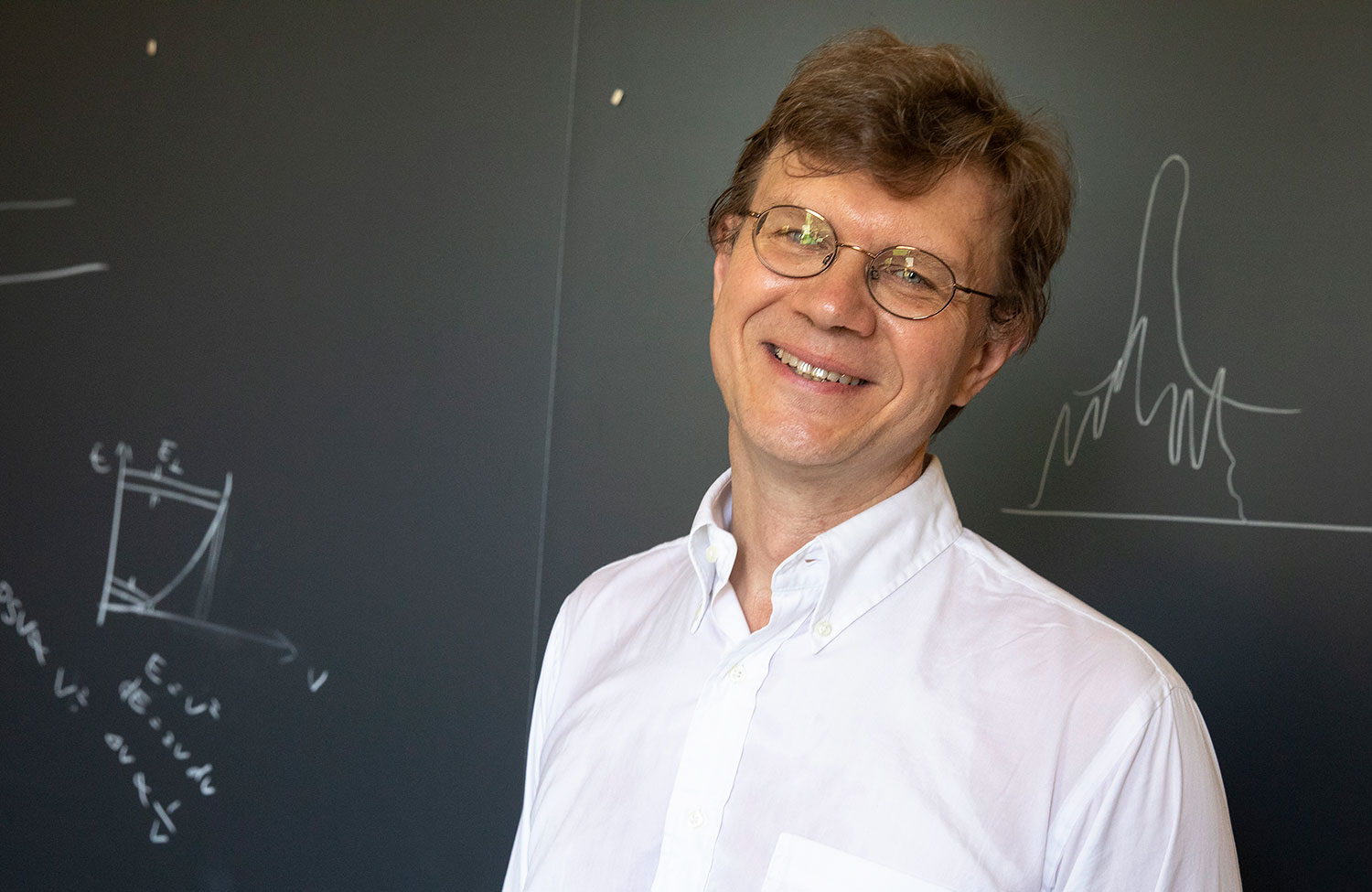 Mikhail Lukin
Mikhail Lukin
George Vasmer Leverett Professor of Physics,
Harvard University
Friday, Feb. 26, 2021 at 3:30 p.m.
Watch the presentation here
Abstract:
I will discuss recent developments at a new scientific interface between quantum optics, quantum many-body physics, information science and engineering. Specifically, I will focus on two examples at this interface involving realization of programmable quantum systems and their first scientific applications. In the first example, I will describe the recent advances involving programmable, coherent manipulation of quantum many-body systems using atom arrays excited into Rydberg states. Recent progress involving programmable quantum simulations with over 200 qubits in two-dimensional arrays, the exploration of exotic many-body phenomena, as well as realization and testing of quantum optimization algorithms will be discussed. In the second example, I will discuss progress towards realization of quantum repeaters for long-distance quantum communication. Specifically, I will describe experimental realization of memory-enhanced quantum communication, which utilizes a solid-state spin memory integrated in a nanophotonic diamond resonator to implement asynchronous Bell-state measurements. Prospects for scaling up these techniques, including realization of larger quantum processors and quantum networks, as well as their novel applications will be discussed.
Bio:
Mikhail Lukin received the Ph.D. degree from Texas A&M University in 1998. He has been a Professor of Physics at Harvard since 2004, where he is currently co-Director of the Harvard Quantum Initiative in Science and Engineering and co-Director of the Harvard-MIT Center for Ultracold Atoms. He has co-authored over 400 technical papers and has received a number of awards, including the Alfred P. Sloan Fellowship, David and Lucile Packard Fellowship for Science and Engineering, NSF Career Award, Adolph Lomb Medal of the Optical Society of America, AAAS Newcomb Cleveland Prize, APS I.I.Rabi Prize, Vannevar Bush Faculty Fellowship, Julius Springer Prize for Applied Physics, and the Willis E. Lamb Award for Laser Science and Quantum Optics. He is a fellow of the OSA, APS, and AAAS and a member of the National Academy of Sciences.
Mikhail Lukin’s research is in the areas of quantum optics and quantum information science. His current interests include quantum manipulation of atomic and nanoscale solid-state systems, quantum metrology and its applications, quantum nonlinear optics and nanophotonics. He and his group are developing new techniques for controlling strongly interacting photons, ultracold atoms, and solid-state atom-like systems. These techniques are used to study fundamental physical phenomena associated with quantum dynamics of many-body systems and to facilitate implementation of novel applications in quantum information processing, quantum communication and quantum metrology. These include realization and studies of novel quantum states of matter away from equilibrium, realization of quantum computers and quantum networks, and development of nanoscale quantum sensors with applications ranging from material science to biological imaging. In the course of this work they are also exploring the new scientific interfaces between quantum optics, atomic physics, condensed matter and information science.
Engineering New Physical Reality: Quantum Computing with Topological Materials
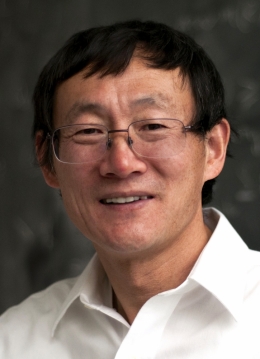 Zhenghan Wang
Zhenghan Wang
University of California, Santa Barbara; Microsoft Station Q; and the Perimeter Institute
Friday, March 12, 2021 at 3:30 p.m.
Watch the presentation here
Abstract:
One unique approach to quantum computing is topological quantum computing. This topological platform requires new materials to be engineered for ideal model Hamiltonions spawned from the most abstract reach of mathematics. I will introduce this approach to a general audience.
Bio:
Zhenghan Wang received his Ph.D in mathematics from UCSD in 1993 working with Fields Medalist Michael Freedman on low dimensional topology. He was then an assistant Professor of Mathematics at University of Michigan from 1993–1996 and Professor of Mathematics at Indiana University at Bloomington from 1996–2007 (1996–1997 on leave as an NSF postdoc at UCSD and 2005–2007 on leave at Microsoft). Currently, Zhenghan is a Professor of Mathematics at UCSB since 2012 (on indefinite leave) and a Distinguished Visiting Research Chair at Perimeter Institute for Theoretical Physics since 2013. He has been a researcher at Station Q since 2005. His main research interests are quantum mathematics, theoretical models of topological phases of matter, and their application to quantum physics and quantum computing.
Quantum Information Science and Engineering at Illinois
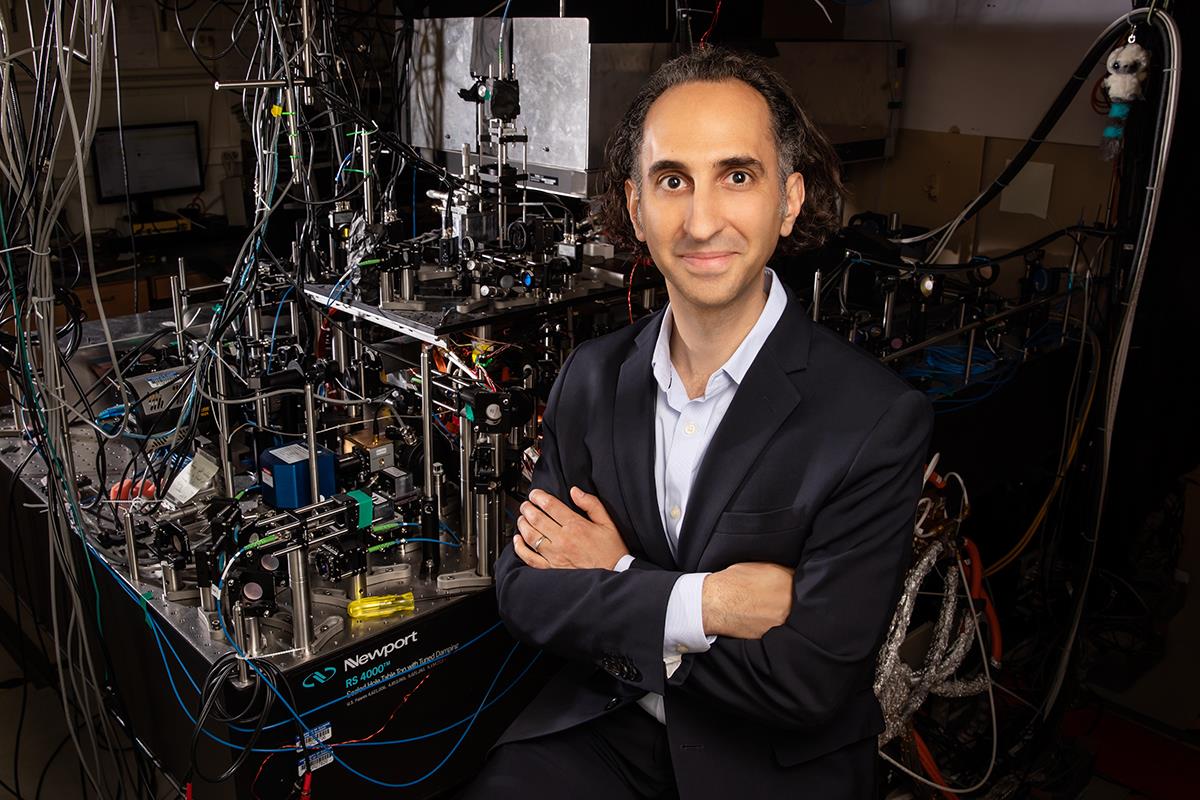
Physics professor Brian DeMarco poses in his research lab at the Loomis Laboratory of Physics in Urbana. Photo by L. Brian Stauffer, University of Illinois at Urbana-Champaign.
Brian DeMarco
Professor of Physics, the University of Illinois at Urbana-Champaign; Director, NSF Quantum Leap Challenge Institute for Hybrid Quantum Architectures and Networks
Friday, April 9, 2021 at 3:30 p.m.
Watch the presentation here
Abstract: We are at just the beginning of the 21st-century quantum technology revolution. Passed in 2018, the bi-partisan National Quantum Initiative Act greatly accelerated development of the national quantum ecosystem. Academic institutions will be a keystone for success in this enterprise by supporting high-risk and inquiry-driven research, incubating technologies for translation, and leading education and workforce development in partnership with the private sector, national labs, and state and local government. I will explain how the University of Illinois has contributed to this opportunity by launching the Illinois Quantum Information Science and Technology center (IQUIST). I will discuss the broad range of IQUIST activities, including new facilities such as our innovative testbed that co-locates superconducting and trapped atomic ion qubit technologies and researchers.
Bio:
Professor Brian DeMarco has advanced the frontier of quantum physics for more than two decades. His research team at Illinois has developed innovative techniques to expand our understanding of materials and particle physics using quantum simulators and is developing new paradigms for quantum computing. In his role as the Chair of the NASA Fundamental Physical Sciences Board, DeMarco has helped to grow US quantum space science, including establishing the Cold Atom Lab on the International Space Station and initiating the future Deep Space Quantum Link. As Director of the new NSF Quantum Leap Challenge Institute for Hybrid Quantum Architectures and Networks, DeMarco is leading an interdisciplinary and multi-institution team of researchers to tackle a central problem: scaling quantum computing and developing new applications using distributed processing systems.
For additional information about Brian DeMarco, please visit his profile page at the University of Illinois at Urbana-Champaign website.
Quantum Computational Supremacy
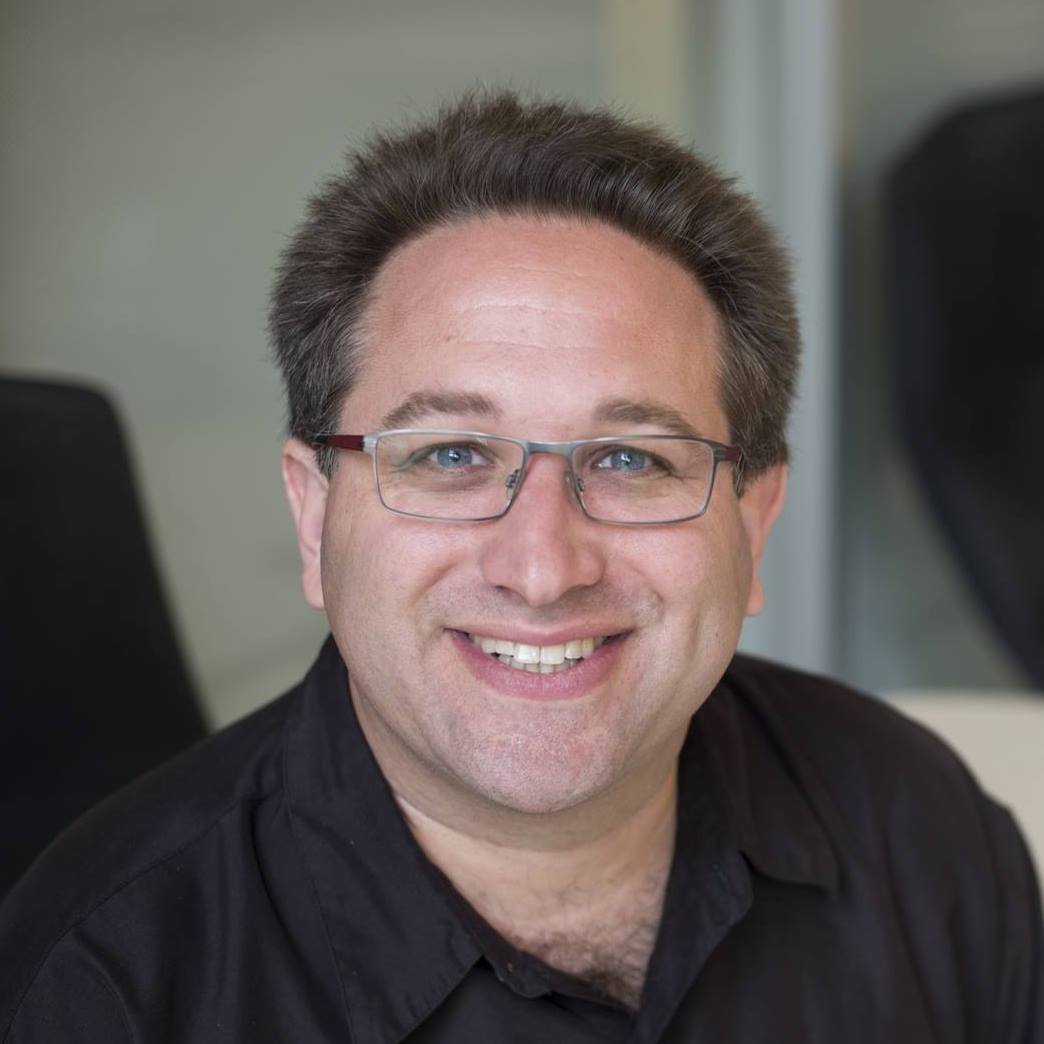 Scott Aaronson
Scott Aaronson
David J. Bruton Centennial Professor of Computer Science, University of Texas at Austin
Friday, April 23, 2021 at 3:45 p.m. EST
Watch the presentation here
Abstract: In Fall 2019, a team at Google made the first-ever claim of “quantum computational supremacy”—that is, a clear quantum speedup over a classical computer for some task—using a 53-qubit programmable superconducting chip called Sycamore. In Fall 2020, a group at USTC in China made a claim of quantum supremacy, using “BosonSampling” (a proposal by me and Alex Arkhipov in 2011) with 50-70 photons in an optical network. In addition to engineering, these accomplishments built on a decade of research in quantum complexity theory. This talk will discuss questions like: what exactly were the contrived computational problems that were solved? How does one verify the outputs using a classical computer? And how sure are we that the problems are indeed classically hard? I’ll end with a proposed application for these sampling-based quantum supremacy experiments—namely, the generation of certified random bits, for use (for example) in proof-of-stake cryptocurrencies—that I’ve been developing and that Google is working to demonstrate.
Bio: Scott Aaronson is David J. Bruton Centennial Professor of Computer Science at the University of Texas at Austin. He received his bachelor’s from Cornell University and his PhD from UC Berkeley. Before coming to UT Austin, he spent nine years as a professor in Electrical Engineering and Computer Science at MIT. Aaronson’s research in theoretical computer science has focused mainly on the capabilities and limits of quantum computers. His first book, Quantum Computing Since Democritus, was published in 2013 by Cambridge University Press. He received the National Science Foundation’s Alan T. Waterman Award, the United States PECASE Award, the Vannevar Bush Faculty Fellowship, the Tomassoni-Chisesi Prize in Physics, and the ACM Prize in Computing, and is a Fellow of the ACM.
If you require an accommodation such as live captioning or interpretation to participate in this event, please contact Jessi Middleton at middleton.85@osu.edu. Requests made 10 business days prior to the event will generally allow us to provide seamless access, but the university will make every effort to meet requests made after this date.
